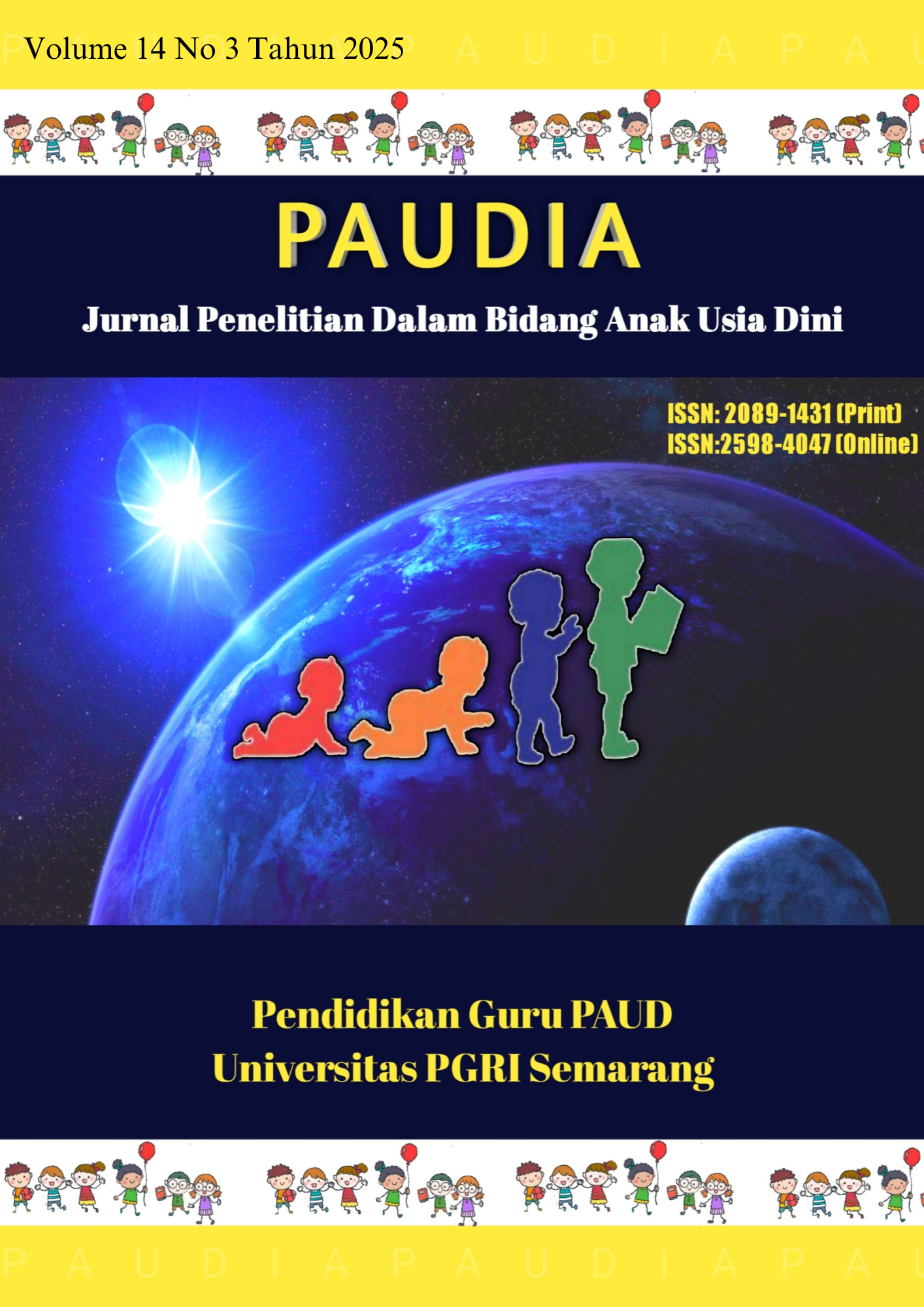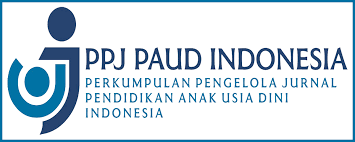Stimulation of Early Childhood Creativity through STEAM Learning Based on Loosparts Media: A Systematic Narrative Review
DOI:
https://doi.org/10.26877/paudia.v14i3.1746Keywords:
Creativity, Loose Parts, STEAMAbstract
The integration of STEAM (Science, Technology, Engineering, Art, and Mathematics) learning in Early Childhood Education is increasingly recognized as essential for cultivating 21st-century skills. This systematic narrative review explores how STEAM learning, when combined with loose parts media, stimulates creativity in early childhood. A total of 515 articles were initially identified through four databases (ProQuest, ERIC, Open Knowledge Map, and Elicit) covering the years 2019–2024. After applying strict inclusion and exclusion criteria, eight peer-reviewed studies were selected for analysis. These studies vary in method, including qualitative, quasi-experimental, and review-based designs, and focus on children aged 3–6 years. The review reveals that loose parts media flexible, open-ended materials enhance key dimensions of creativity such as imagination, originality, problem-solving, collaboration, and innovation when implemented within the STEAM framework. Children engaged in these activities exhibit higher levels of critical thinking and exploratory learning. The findings also highlight the importance of teacher facilitation, cultural context, and long-term developmental impact. This review enriches both practical and theoretical understanding of creative learning strategies based on loose parts within the STEAM framework in early childhood education. It contributes new insights by synthesizing studies that explicitly connect both components, which are often examined separately. Educators and policymakers are encouraged to incorporate this integrative approach into early learning environments to maximize children’s cognitive and creative growth.
References
Antika, D. H. W., Hartono, & Setiawan, D. (2025). Development of Smart Train PAUD Learning Media Based on the Principle of Reuse. PAUDIA: Jurnal Penelitian Dalam Bidang Pendidikan Anak Usia Dini, 14(2), 280–295.
Braun, V., & Clarke, V. (2014). What can “thematic analysis” offer health and wellbeing researchers? In International Journal of Qualitative Studies on Health and Well-being (Vol. 9). https://doi.org/10.3402/qhw.v9.26152
Cabello, V. M., Loreto Martínez, M., Armijo, S., & Maldonado, L. (2021). Promoting STEAM learning in the early years: “Pequeños Científicos” Program. Lumat, 9(2), 33–62. https://doi.org/10.31129/lumat.9.2.1401
Dewi, A. C., Alif Laini, Sri Intan Wahyuni, & Mega Cahya Dwi Lestari. (2024). Enhancing early childhood creativity through loose-parts media based on STEAM learning. Aṭfālunā Journal of Islamic Early Childhood Education, 7(1), 31–46. https://doi.org/10.32505/atfaluna.v7i1.8113
Gough, D. (2007). Weight of evidence: A framework for the appraisal of the quality and relevance of evidence. Research Papers in Education, 22(2). https://doi.org/10.1080/02671520701296189
Jamal, N. A., & Sugiarti, R. (2022). The Creativity of Early Childhood in Urban Areas of Indonesia: A Literature Review. International Journal of Innovative Research and Development, 11(1), 65–69. https://doi.org/10.24940/ijird/2022/v11/i1/jan22026
Maghfirotul Qiromah, I., Hadi Pradana, P., & Hasanah, H. (2024). Improving Early Childhood Creative Thinking Skills Through Nature-Based Loose Parts Media. Child Education Journal, 5(3), 180–189. https://doi.org/10.33086/cej.v5i3.5759
Mamma, A. T., & Cenderawasih, U. (2021). Improving Children ’ S Creativity Through. 3(1), 31–41.
Munawar, M., Roshayanti, F., & Sugiyanti, S. (2019). IMPLEMENTATION OF STEAM (Science Technology Engineering Art Mathematics) - BASED EARLY CHILDHOOD EDUCATION LEARNING IN SEMARANG CITY. CERIA (Cerdas Energik Responsif Inovatif Adaptif), 2(5), 276. https://doi.org/10.22460/ceria.v2i5.p276-285
Nipriansyah, N., Sasongko, R. N., Kristiawan, M., Susanto, E., & Arinal Hasanah, P. F. (2021). Increase Creativity And Imagination Children Through Learning Science, Technologic, Engineering, Art And Mathematic With Loose Parts Media. Al-Athfaal: Jurnal Ilmiah Pendidikan Anak Usia Dini, 4(1), 77–89. https://doi.org/10.24042/ajipaud.v4i1.8598
Novita Ananda, Parwoto, P., & Ilyas, S. N. (2023). Efektivitas Pembelajaran Berbasis Steam Dengan Media Loose Parts Terhadap Kreativitas Anak Usia Dini. Jurnal Buah Hati, 10(2), 76–92. https://doi.org/10.46244/buahhati.v10i2.2276
Purwati, D., Astawan, I. G., & Antara, P. A. (2024). Enhancing Creative Imagination Ability in Early Childhood: A Study on Differential Learning Assisted with Loose Parts Media and Social Skills. Jurnal Pendidikan Anak Usia Dini Undiksha, 12(1), 26–35. https://doi.org/10.23887/paud.v12i1.74007
Rahardjo, M. M. (2019). How to use Loose-Parts in STEAM? Early Childhood Educators Focus Group discussion in Indonesia. JPUD - Jurnal Pendidikan Usia Dini, 13(2), 310–326. https://doi.org/10.21009/jpud.132.08
Rahmawati, Y. P., Handayani, A., & Rakhmawati, D. (2024). Efektivitas Penggunaan Media Virtual Reality Dalam Pembelajaran Sains. PAUDIA: Jurnal Penelitian Dalam Bidang Pendidikan Anak Usia Dini, 13(2).
Saputri, W. D., Ponorogo, U. M., Mahardani, A. J., Ponorogo, U. M., Wulansari, B. Y., & Ponorogo, U. M. (2024). Lectura : Jurnal Pendidikan. 15, 497–508.
Sardi, M., & Mayar, F. (2023). The Effect of Loose Parts on the Development of Early Childhood Creativity. AL-ISHLAH: Jurnal Pendidikan, 15(3), 4120–4128. https://doi.org/10.35445/alishlah.v15i3.4107
Sekhon, M., De Thurah, A., Fragoulis, G. E., Schoones, J., Stamm, T. A., Vliet Vlieland, T. P. M., Esbensen, B. A., Lempp, H., Bearne, L., Kouloumas, M., Pchelnikova, P., Swinnen, T. W., Blunt, C., Ferreira, R. J. O., Carmona, L., & Nikiphorou, E. (2024). Synthesis of guidance available for assessing methodological quality and grading of evidence from qualitative research to inform clinical recommendations: A systematic literature review. RMD Open, 10(2), 1–10. https://doi.org/10.1136/rmdopen-2023-004032
Shenita, A., Oktavia, W., Aditya Rahman, N., Lisfi Irmareta, I., Subrata, H., Rahmawati, I., & Lutfi Choirunnisa, N. (2022). PEMBELAJARAN SENI MUSIK BOTOL KACA BERBASIS PROYEK DENGAN PENDEKATAN STEAM UNTUK MENINGKATKAN KREATIVITAS SISWA. ENGGANG: Jurnal Pendidikan, Bahasa, Sastra, Seni, Dan Budaya, 2(2). https://doi.org/10.37304/enggang.v3i1.4939
Sudarso, Y., Mulia, T., Deli, K. M., Medan, K., & Utara, S. (2024). Stimulasi Kreativitas Anak Melalui Media Loose Part di KB ONSIF Kota Gunungsitoli usaha yang harus ditingkatkan dan dilaksanakan dengan optimal . Banyak penelitian telah dapat diasah dan dikembangkan . Andriani , 2023 “ Pengembangan Kreativitas Anak Usia. 2(2).
Sukardjo, M., Nirmala, B., Ruiyat, S. A., Annuar, H., & Khasanah5, U. (2023). Loose Parts: Stimulation of 21st Century Learning Skills (4C Elements). Jurnal Obsesi : Jurnal Pendidikan Anak Usia Dini, 7(1), 1073–1086. https://doi.org/10.31004/obsesi.v7i1.4088
Susanti, F. M., Hidayati, S., Aghnaita, A., & Muzakki, M. (2023). Creativity Development of Children 5-6 years old Through Loose Parts Media. ThufuLA: Jurnal Inovasi Pendidikan Guru Raudhatul Athfal, 11(1), 21. https://doi.org/10.21043/thufula.v11i1.20114
Trina, N. A., Monsur, M., Cosco, N., Shine, S., Loon, L., & Mastergeorge, A. (2024). How Do Nature-Based Outdoor Learning Environments Affect Preschoolers’ STEAM Concept Formation? A Scoping Review. Education Sciences, 14(6). https://doi.org/10.3390/educsci14060627
Wibowo, A., & Putri, S. (2021). Pedoman Praktis Penyusunan Naskah Ilmiah. July, 66. https://doi.org/10.13140/RG.2.2.17871.20640
Wised, S. (2024). The Evolution of STEAM-Based Programs : Fostering Critical Thinking , Collaboration , and Real-World Application. 1(August), 13–22.
Downloads
Published
Issue
Section
License
Copyright (c) 2025 Siti Qoumariah, Noviana Mustapa, Siti Aisyah, St. Maria Ulfah, Titi Chandrawati

This work is licensed under a Creative Commons Attribution-NonCommercial-ShareAlike 4.0 International License.






